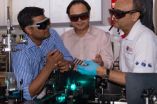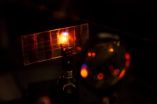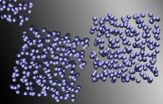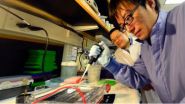(Press-News.org) In future, when your mobile or tablet runs out of battery, you could just recharge it by putting it out in the sun.
Nanyang Technological University (NTU) scientists have developed a next-generation solar cell material which can also emit light, in addition to converting light to electricity.
This solar cell is developed from Perovskite, a promising material that could hold the key to creating high-efficiency, inexpensive solar cells. The new cells not only glow when electricity passes through them, but they can also be customised to emit different colours.
Picture this: A shopping mall facade could be storing solar energy in the day and transforms into a light display for advertisements that glows at night.
This discovery, published in top academic journal Nature Materials, was discovered almost by chance when NTU physicist Sum Tze Chien, asked his postdoctoral researcher Xing Guichuan to shine a laser on the new hybrid Perovskite solar cell material they are developing.
Assistant Professor Sum said to the team's surprise, the new Perovskite solar cell glowed brightly when a laser beam was shone on it. This is a significant finding as most solar cell materials are good at absorbing light but are generally not expected to generate light. In fact, this highly luminescent new Perovskite material is also very suitable for the making of lasers.
"What we have discovered is that because it is a high quality material, and very durable under light exposure, it can capture light particles and convert them to electricity, or vice versa," said Asst Prof Sum, a Singaporean scientist at NTU's School of Physical and Mathematical Sciences (SPMS).
"By tuning the composition of the material, we can make it emit a wide range of colours, which also makes it suitable as a light emitting device, such as flat screen displays."
His research partner, Assistant Professor Nripan Mathews from the School of Materials Science and Engineering (MSE) and the Energy Research Institute @ NTU (ERI@N), said this newly discovered property is expected to enable the industry to feasibly adopt the material for use into existing technology.
"What we have now is a solar cell material that can be made semi-translucent. It can be used as tinted glass to replace current windows, yet it is able to generate electricity from sunlight.
"The fact that it can also emit light makes it useful as light decorations or displays for the facades of shopping malls and offices," said Dr Mathews, who is also the Singapore R&D Director of the Singapore-Berkeley Research Initiative for Sustainable Energy (SinBeRISE) NRF CREATE program.
"Such a versatile yet low-cost material would be a boon for green buildings. Since we are already working on the scaling up of these materials for large-scale solar cells, it is pretty straightforward to modify the procedures to fabricate light emitting devices as well. More significantly, the ability of this material to lase, has implications for on-chip electronic devices that source, detect and control light," he added.
This NTU breakthrough has already won praise from experts. Professor Ramamoorthy Ramesh, the Purnendu Chatterjee Endowed Chair in Energy Technologies professor at the University of California, Berkeley in the United States said: "This work from the NTU SinBeRISE team clearly shows the promise of such new materials in a broad range of applications, including solar cells and now for lasing. It also shows the power of interdisciplinary, basic science in making fundamental discoveries that will impact in a broad sense."
Professor Ramesh, an award-winning scientist highly regarded worldwide by both academia and industry, has over two decades of experience leading world-class research in the areas of electronics and solar materials.
The inner workings of the new NTU solar cell material were published in the world's top scientific journal, Science, in October last year by the same NTU research group.
The advanced material, which is currently patent pending, is five times cheaper than current Silicon-based solar cells. This is due to its easy solution-based manufacturing process, which works by combining two or more chemicals at room temperature.
INFORMATION:
The NTU team, consisting of eight scientists and researchers, has been working on this Perovskite research project since early 2013. The project was funded by NTU and the National Research Foundation (NRF) Prime Minister's Office, Singapore, under its Campus for Research Excellence and Technological Enterprise (CREATE) programme.
Media contact:
Lester Kok
Senior Assistant Manager
Corporate Communications Office
Nanyang Technological University
Tel: 6790 6804
Email: lesterkok@ntu.edu.sg
About Nanyang Technological University
A research-intensive public university, Nanyang Technological University (NTU) has 33,500 undergraduate and postgraduate students in the colleges of Engineering, Business, Science, Humanities, Arts, & Social Sciences, and its Interdisciplinary Graduate School. It has a new medical school, the Lee Kong Chian School of Medicine, set up jointly with Imperial College London.
NTU is also home to world-class autonomous institutes – the National Institute of Education, S Rajaratnam School of International Studies, Earth Observatory of Singapore, and Singapore Centre on Environmental Life Sciences Engineering – and various leading research centres such as the Nanyang Environment & Water Research Institute (NEWRI), Energy Research Institute @ NTU (ERI@N) and the Institute on Asian Consumer Insight (ACI).
A fast-growing university with an international outlook, NTU is putting its global stamp on Five Peaks of Excellence: Sustainable Earth, Future Healthcare, New Media, New Silk Road, and Innovation Asia.
Besides the main Yunnan Garden campus, NTU also has a satellite campus in Singapore's science and tech hub, one-north, and a third campus in Novena, Singapore's medical district.
For more information, visit http://www.ntu.edu.sg
NTU scientists discover material that can be solar cell by day, light panel by night
New material could lead to new touch and display screens doubling up as solar panels
2014-03-24
ELSE PRESS RELEASES FROM THIS DATE:
'RoboClam' replicates a clam's ability to burrow while using little energy
2014-03-24
The Atlantic razor clam uses very little energy to burrow into undersea soil at high speed. Now a detailed insight into how the animal digs has led to the development of a robotic clam that can perform the same trick.
The device, known as "RoboClam," could be used to dig itself into the ground to bury anchors or destroy underwater mines, according to its developer, Amos Winter, the Robert N. Noyce Career Development Assistant Professor of Mechanical Engineering at MIT.
Despite its rigid shell, the Atlantic razor clam (Ensis directus) can move through soil at a speed ...
A new concept for manufacturing wrinkling patterns on hard-nano-film/soft-matter-substrate
2014-03-24
Wrinkling is a common phenomenon for thin stiff film adhered on soft substrate. Various wrinkling phenomenon has been reported previously. Wu Dan, Yin Yajun, Xie Huimin,et al from Tsinghua University proposed a new method to control wrinkling and buckling of thin stiff film on soft substrate. It is found that the curve pattern on the soft substrate has obvious influence on the wrinkling distribution of the thin film/soft substrate. Their work, entitled "Controlling the surface buckling wrinkles by patterning the material system of hard-nano-film/soft-matter-substrate", ...
Psychiatric complications in women with PCOS often linked to menstrual irr
2014-03-24
(NEW YORK, NY, March 24, 2014) – Polycystic ovary syndrome (PCOS), a hormone imbalance that causes infertility, obesity, and excessive facial hair in women, can also lead to severe mental health issues including anxiety, depression, and eating disorders. A study supervised by Columbia University School of Nursing professor Nancy Reame, MSN, PhD, FAAN, and published in the Journal of Behavioral Health Services & Research, identifies the PCOS complications that may be most responsible for psychiatric problems. While weight gain and unwanted body hair can be distressing, irregular ...
Statins could ease coughing in lung disease patients, study finds
2014-03-24
Common cholesterol-lowering drugs could provide relief to patients suffering from a chronic lung disease, a study has shown.
The drugs – known as statins – were found to help alleviate the chronic coughing associated with the disease for some patients.
Statins are commonly prescribed for people at risk of heart attack because they can reduce cholesterol levels, but scientists are increasingly finding that they also have anti-inflammatory effects.
Researchers at the University of Edinburgh have shown the therapeutic potential of statins to treat patients with an inflammatory ...
Gene implicated in progression and relapse of deadly breast cancer finding points to potential Achilles' heel in triple negative breast cancer
2014-03-24
NEW YORK – (March 24, 2014) – Scientists from Weill Cornell Medical College and Houston Methodist have found that a gene previously unassociated with breast cancer plays a pivotal role in the growth and progression of the triple negative form of the disease, a particularly deadly strain that often has few treatment options. Their research, published in this week's Nature, suggests that targeting the gene may be a new approach to treating the disease.
About 42,000 new cases of triple negative breast cancer (TNBC) are diagnosed in the United States each year, about 20 ...
Like being inside a star
2014-03-24
Some experiments are really difficult to perform in practice. To gain a detailed understanding of the behaviour of molecular hydrogen (H2), for example, we would have to produce such high pressures as those occurring within the core of gaseous planets like Jupiter and Saturn or inside stars. If such conditions cannot be created, an alternative method is to simulate them on the computer, but the model has to be accurate. A group of research scientists from the International School for Advanced Studies (SISSA) in Trieste used a simulation model that is far more accurate than ...
Pioneering research offers new insight into improved wave energy testing
2014-03-24
Pioneering research could provide a significant boost in the vital quest to harness wave power as a viable renewable energy source for the future.
Scientists from the University of Exeter have studied how wave energy developers can more accurately measure, and predict the wave conditions within wave energy test sites.
The research, which is published in leading scientific journal Energy, deployed wave measurement buoys and used wave modelling to show how variations in wave size and strength could be resolved.
The results should aid developers to better predict sea ...
Maturitas publishes position statement on management of vertebral osteoporotic fracture
2014-03-24
Amsterdam, March 24, 2014 – Elsevier, a world-leading provider of scientific, technical and medical information products and services, today announced the publication of a position statement by the European Menopause and Andropause Society (EMAS) in the journal Maturitas on the topic of the management of postmenopausal women with vertebral osteoporotic fracture.
Vertebral osteoporotic fracture is an underestimated condition as only about a third of people with the disease seek medical attention. While it may cause acute back pain, the presentation may be insidious with ...
Protein called YAP gives blood vessels strength, shape
2014-03-24
AUGUSTA, Ga. - A protein known to promote cancer appears to give the blood vessels strength and shape, researchers report.
When yes-associated protein, or YAP, is deleted from vascular smooth muscle cells during development, the protein makes thin-walled blood vessels that over-dilate in response to the usual pressure of blood flow, said Dr. Jiliang Zhou, vascular biologist at the Medical College of Georgia at Georgia Regents University.
"The thickness of the arterial wall decreases from three or four layers of smooth muscle cells to one or two layers," said Zhou, corresponding ...
From mouse ears to man's?
2014-03-24
One in a thousand children in the United States is deaf, and one in three adults will experience significant hearing loss after the age of 65. Whether the result of genetic or environmental factors, hearing loss costs billions of dollars in healthcare expenses every year, making the search for a cure critical.
Now a team of researchers led by Karen B. Avraham of the Department of Human Molecular Genetics and Biochemistry at Tel Aviv University's Sackler Faculty of Medicine and Yehoash Raphael of the Department of Otolaryngology–Head and Neck Surgery at University of ...
LAST 30 PRESS RELEASES:
Low daily alcohol intake linked to 50% heightened mouth cancer risk in India
American Meteorological Society announces Rick Spinrad as 2026 President-Elect
Biomass-based carbon capture spotlighted in newly released global climate webinar recording
Illuminating invisible nano pollutants: advanced bioimaging tracks the full journey of emerging nanoscale contaminants in living systems
How does age affect recovery from spinal cord injury?
Novel AI tool offers prognosis for patients with head and neck cancer
Fathers’ microplastic exposure tied to their children’s metabolic problems
Research validates laboratory model for studying high-grade serous ovarian cancer
SIR 2026 delivers transformative breakthroughs in minimally invasive medicine to improve patient care
Stem Cell Reports most downloaded papers of 2025 highlight the breadth and impact of stem cell research
Oxford-led study estimates NHS spends around 3% of its primary and secondary care budget on the health impacts of heat and cold in England
A researcher’s long quest leads to a smart composite breakthrough
Urban wild bees act as “microbial sensors” of city health.
New study finds where you live affects recovery after a hip fracture
Forecasting the impact of fully automated vehicle adoption on US road traffic injuries
Alcohol-related hospitalizations from 2016 to 2022
Semaglutide and hospitalizations in patients with obesity and established cardiovascular disease
Researchers ‘listen in’ to embryo-mother interactions during implantation using a culture system replicating the womb lining
How changing your diet could help save the world
How to make AI truly scalable and reliable for real-time traffic assignment?
Beyond fragmented markets: A new framework for efficient and stable ride-pooling
Can shape priors make road perception more reliable for autonomous driving?
AI tracks nearly 100 years of aging research, revealing key trends and gaps
Innovative techniques enable Italy’s first imaging of individual trapped atoms
KIER successfully develops Korea-made “calibration thermoelectric module” for measuring thermoelectric device performance
Diversifying US Midwest farming for stability and resilience
Emphasizing immigrants’ deservingness shifts attitudes
Japanese eels, climate change, and river temperature
Pusan National University researchers discover faster, smarter heat treatment for lightweight magnesium metals
China’s 2024 Gastroenterology Report: marked progress in endoscopy quality and disease management
[Press-News.org] NTU scientists discover material that can be solar cell by day, light panel by nightNew material could lead to new touch and display screens doubling up as solar panels





